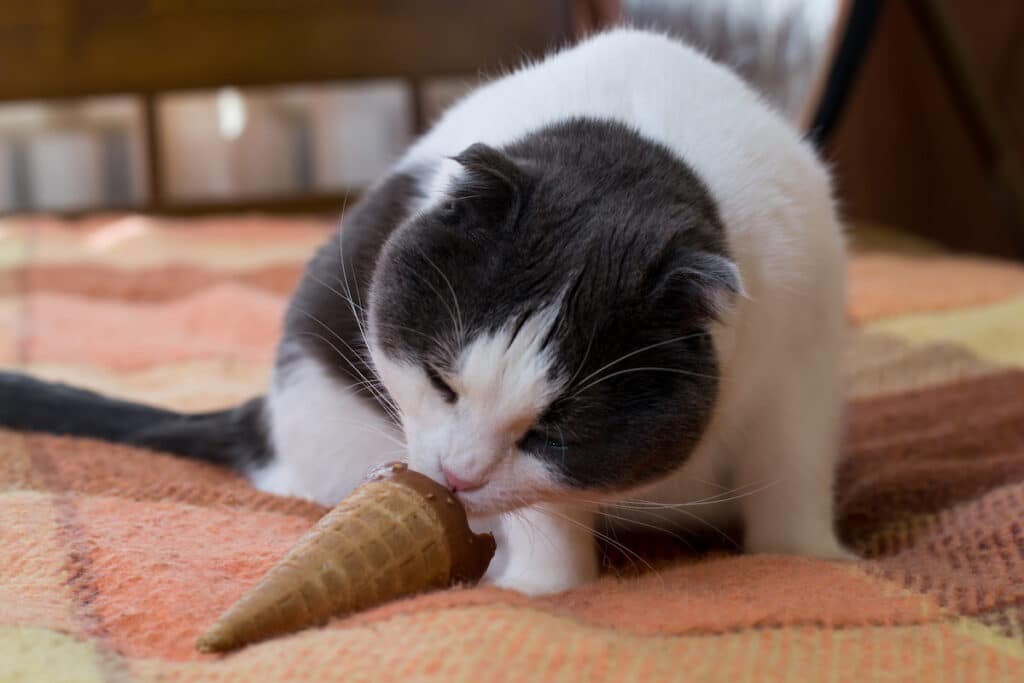Chocolate is a delicious treat that humans enjoy, but it can be poisonous to cats. If your cat has eaten chocolate, it’s important to take immediate action. Understanding the risks of chocolate toxicity and knowing what to do in an emergency can help you keep your cat safe. In this article, we’ll go over what to do if your cat eats chocolate.
Signs and Symptoms of Chocolate Toxicity in Cats
Chocolate toxicity in cats can be a serious problem, so it’s important to be aware of the signs and symptoms. Here are some of the most common signs and symptoms of chocolate toxicity in cats:
- Vomiting and diarrhea
- Increased heart rate
- Muscle tremors
- Seizures
- Elevated body temperature
- Increased thirst
- Abnormal behavior
- Difficulty breathing
- Coma
If your cat has ingested chocolate, it’s important to seek veterinary care immediately. Prompt treatment can help reduce the risk of serious complications from chocolate toxicity.
Risk Factors for Chocolate Toxicity
Chocolate toxicity is a serious issue for cats, as even small amounts of chocolate can be extremely dangerous. It is important for pet owners to be aware of the risk factors associated with chocolate toxicity in cats.
First and foremost, the type of chocolate is an important factor. Dark chocolate and baking chocolate contain the highest concentrations of theobromine, the chemical that can cause toxicity in cats. While white chocolate contains a very small amount of theobromine, even it can be dangerous in large amounts.
The size of the cat plays an important role as well. Smaller cats can become sick after ingesting even a small amount of chocolate. On the other hand, larger cats may be able to tolerate slightly larger doses of chocolate without experiencing any adverse effects.
Finally, the amount of chocolate that the cat ingests can be a major factor. Even a few small pieces of chocolate can be enough to make a cat very ill. It is important for pet owners to be aware of the amount of chocolate their cats are consuming and take steps to prevent them from eating too much.

What to Do if Your Cat Eats Chocolate
If your cat has eaten chocolate, it is important to take immediate action. The first step is to remove any remaining chocolate from your cat’s reach. Then, it is important to assess the quantity of chocolate your cat has ingested. The amount of chocolate your cat has consumed will determine the severity of the potential reaction. If a small amount of chocolate was consumed, your cat may experience mild symptoms such as vomiting and diarrhea. However, if a large amount of chocolate was consumed, your cat may experience more severe symptoms such as seizures, heart arrhythmias, and even death.
If you believe your cat has consumed chocolate, it is important to contact your veterinarian immediately. Your veterinarian can recommend the best course of action and provide treatment to help mitigate any potential symptoms. In some cases, your veterinarian may suggest inducing vomiting, giving activated charcoal, or providing other supportive care.
It is important to remember that chocolate can be potentially deadly for cats and should always be kept out of their reach. If you think your cat has consumed chocolate, take immediate action and contact your veterinarian right away. If you’re unsure of what to do if your cat eats chocolate, the safest action is to call Pet Poison control or contact your vet.
Preventing Chocolate Poisoning
Hopefully, you’ll never have to wonder what to do if your cat eats chocolate. The good news is that chocolate poisoning can be prevented by taking a few simple steps.
First, it’s important to keep all chocolate products out of your cat’s reach. This means storing them in cupboards, shelves, or closed containers that your cat cannot access. Additionally, you should be mindful of any chocolate products that may be left out in the open, such as chocolate-covered snacks, bars, and other treats.
Second, be aware of the potential danger of giving your cat any human food. Chocolate is particularly toxic to cats, so it’s important to avoid giving them any type of chocolate in any form.
Finally, try to make sure your cat is not exposed to chocolate in any way. This may include making sure your cat does not have access to any open products containing chocolate or to any areas where chocolate may be present. It’s also important to be aware of any visitors who may bring any chocolate products into your home.
By taking these simple steps, you can help to ensure that your cat stays safe from chocolate poisoning.
How much chocolate is poisonous to cats?
Cats are incredibly curious creatures, and it can be tempting to give them a treat of chocolate. However, cats should not consume chocolate due to its poisonous nature. Chocolate contains a chemical known as theobromine which is toxic to cats. Depending on the type of chocolate, the amount of theobromine can vary, with dark chocolate having the highest concentration. As little as 20 grams of dark chocolate can be toxic to a cat, and can cause symptoms such as vomiting, diarrhea, increased heart rate and even seizures. In some cases, theobromine poisoning can be fatal. If you suspect your cat has consumed chocolate, contact your vet immediately.
How long does it take for chocolate to affect a cat?
It is not recommended to feed your cat chocolate, under any circumstances. Chocolate contains theobromine, which is a stimulant that can cause severe and potentially fatal reactions in cats. If your cat accidentally ingests chocolate, it can take anywhere from 6 to 12 hours for the chocolate to take effect.
The signs of chocolate poisoning in cats include vomiting, diarrhea, excessive thirst, restlessness, elevated heart rate, and seizures. If you notice any of these symptoms, it is important to take your cat to the vet immediately.
Your vet will likely induce vomiting and give your cat activated charcoal, to help absorb the theobromine in the chocolate. They may also give your cat fluids to help flush out the toxins. If your cat is having a severe reaction, your vet may also provide supportive treatments to help your cat recover.
It is important to note that the effects of chocolate on cats can vary depending on the amount of chocolate ingested, the type of chocolate, and the size of the cat. For these reasons, it is best to err on the side of caution and take your cat to the vet if you suspect chocolate poisoning.
Takeaway
Chocolate can be poisonous to cats, and it’s important to take immediate action if you suspect that your cat has eaten chocolate. Knowing what to do if your cat eats chocolate can potentially save their life. Watch for signs of toxicity, and contact your veterinarian or the Pet Poison Helpline if you know how much chocolate was eaten. The best way to protect your cat from chocolate poisoning is to keep all chocolate products out of reach.
FAQs: What to do if Cat Eats Chocolate?
It is a common misconception that cats can survive eating chocolate. The truth of the matter is that chocolate is toxic to cats, and can even be fatal if ingested in large quantities. Chocolate contains theobromine, a compound that is toxic to cats, and can cause serious symptoms such as vomiting, seizures, and even death. If your cat has consumed chocolate, you should contact your veterinarian immediately. Symptoms can vary, but can include vomiting, diarrhea, restlessness, and an increased heart rate. In severe cases, chocolate can cause tremors, seizures, and even death. If you suspect your cat has eaten chocolate, monitor them closely and contact your veterinarian right away. If the chocolate was consumed in large amounts, they may need to be hospitalized and given supportive care.
It is important to keep in mind that cats are much more sensitive to theobromine than other animals. As such, it is crucial to keep chocolate away from cats at all costs. If you must give your cat a treat, opt for something that is specifically designed for cats, such as catnip or a commercial cat treat.
If your cat licks a small amount of chocolate, it’s unlikely to cause any serious harm. In fact, many cats are drawn to the sweet taste of chocolate, so it’s not uncommon for them to sneak a lick or two. That being said, chocolate can still be toxic to cats and can cause a range of symptoms, including vomiting, diarrhea, excessive panting, and even seizures.
The amount of chocolate that will cause toxicity depends on the type and amount of the chocolate, as well as the size and health of the cat. For example, a small piece of milk chocolate may cause mild symptoms in a large healthy cat, while a small piece of dark chocolate could cause severe toxicity in a small or elderly cat.
If you think your cat has licked a small amount of chocolate, it’s best to monitor them carefully for any signs of distress. If you notice any signs of toxicity, such as vomiting or diarrhea, contact your vet right away. Your vet can advise you on the best course of action for your pet.
If a cat has been poisoned, they will typically display some common symptoms. Vomiting, diarrhea, and loss of appetite are all indications that something is wrong. Additionally, a poisoned cat may appear lethargic, weak, and have trouble breathing. They may also experience seizures or tremors. If you suspect that your cat has been poisoned, you should take them to the veterinarian immediately. There, your vet will be able to determine the best course of action to help your cat recover.
If you suspect that your cat has ingested a toxic substance, it is important to induce vomiting right away. This can be done by giving your cat hydrogen peroxide. To do this, mix 1 teaspoon of 3% hydrogen peroxide per 5 pounds (2.3 kilograms) of body weight. Using an eye dropper or syringe, squirt the solution into the side of the cat’s mouth. Your cat should begin vomiting within 20-30 minutes. If it does not, you can repeat the process. It is important to note that hydrogen peroxide should not be given to cats who are dehydrated, have had recent stomach surgery, or have an underlying medical condition. If your cat does not vomit after the second dose, contact your veterinarian for further instructions.














